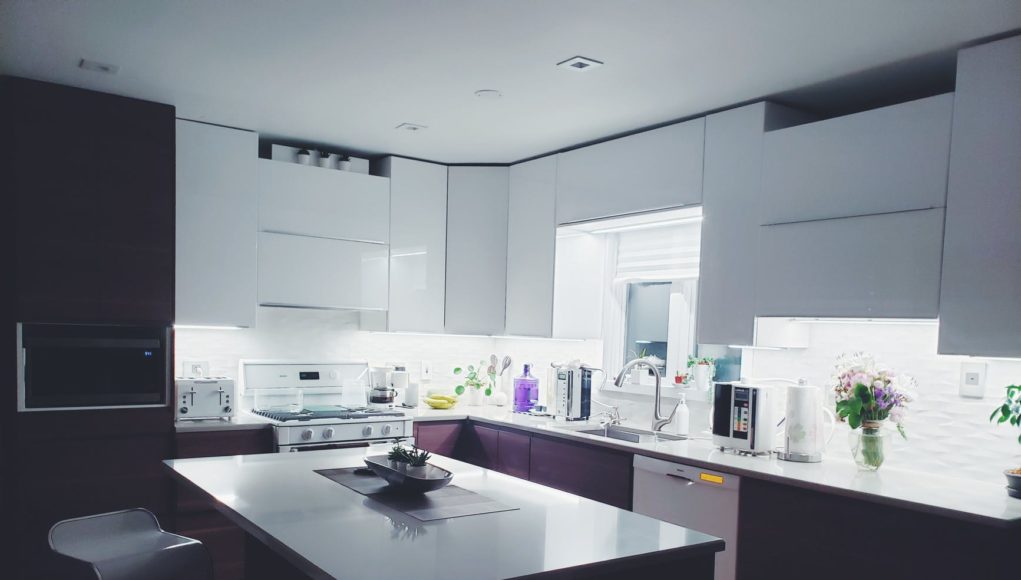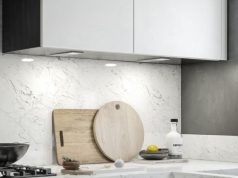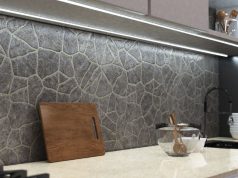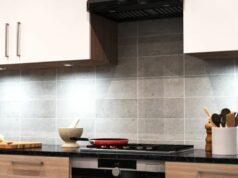Because of its subtlety, versatility and functionality, under-cabinet lighting has been on the rise in popularity for some time now. It is usually linked to modern and minimalistic styles and can be found mostly in kitchens. However, it is not a rule set in stone, and it can be successfully implemented in virtually every room. As long as the lights are correctly installed, and the whole home decor remains consistent, you can get creative.
What is more, with some basic skills, you can install under-cabinet lighting all by yourself, or at least do a part of the job and hire a professional for the other part. If you are considering cabinet lights for your house, this article will provide you with all the necessary information. Hopefully, it will help you make the right decision.
Where Can You Use Under Cabinet Lighting?
The most common placement for this fixture is in the kitchen where it works perfectly as task lighting. Installed under cabinets, just above the countertops, will provide you with much-needed light while you prepare your food and ensure you don’t cut your finger or you blend ingredients well.
Also, it is not unusual for people to have lights under their cabinets in the bathroom.
However, as was already mentioned, as long as you have a reasonable plan, you can have these lights underneath or inside every cabinet or cupboard, no matter the room.
What Are the Types of Under Cabinet Lighting?
Puck Lights
It has been a highly popular choice for under-cabinet lighting for quite some time now. Its name comes from the fact that the fixtures are shaped like hockey pucks – short, round, and around 5-6 cm in diameter. Most often, they use halogen or LED bulbs. You usually need only screws to install them on the underside of a cabinet.
Not all of them operate on 120V AC directly, so if you have chosen puck lights, check this, because you may need a transformer for them to work, and a transformer is not always easy to hide.
In the case of LED bulbs, they don’t operate on the AC line voltage at all, so they will need a power supply as a convertor unless you find LED lights that can be powered by a battery. It is the best option if you don’t have any space to hide a power supply and you want to avoid loose cables.
When it comes to their looks, they cast a light beam similar to a stage spotlight, only smaller and a bit more subtle. It is recommended to place them around 30-50 cm apart from each other.
Strip Lights
Contrary to puck lights, strip lighting provides more linear lights evenly across the counter. In this case, most electronics are already embedded into the fixture, so the installation is pretty easy, even for someone inexperienced.
Nowadays, LED strip lights are growing in popularity, though fluorescent strip lights used to be more common in the past. However, they have more disadvantages than their LED counterparts (mercury content, energy-consuming, bright light).
There is usually no need for additional power supplies or transformers, which makes them very comfortable to install and use.
There are also very similar bar lights, but they have more visible fixtures.
Rope Lights
Rope lights are similar to strip lights, but strip lights come with changing options, as their bulbs are mounted on the surface, while in the case of rope lights, the bulbs are encased in a kind of tube. Ropes may also fit better if you plan to put the lights in a corner, as they bend more easily. They also provide a bit dimmer light than strip lights.
Why Should You Choose Under Cabinet Lighting?
Under cabinet lighting is growing in popularity, and it is not difficult to understand why. Here are some of the most appreciated advantages:
Task lighting
According to the name, these lights are to be installed under or inside cabinets, or cupboards. They usually provide bright, focused light to whatever is directly below them, which makes them the perfect task lighting. This is why they are so commonly used in modern kitchens, where the proper light is required for food preparation that often requires precision.
Efficiency
There is no need to add an entire lamp or a fixture, so you don’t need any additional space – you install it under cabinets that are already in place. It is definitely handier, plus, more cost-effective than adding any other source of light to a room.
Mounted under cabinets, kitchen cupboard lights direct the light exactly where you require it. Task lighting is much more cost and energy-effective, because you use it only when you need it, and there is no light wasting energy all over the room. What is more, lights for kitchen units and other pieces of furniture are usually LED or halogen, which makes them even more efficient.
Aesthetics
This lighting is also easy on the eyes and great at setting the right mood. So after you are done with food preparation, you can chill out in the kitchen, enjoying your dinner, with the lovely ambience around you. It is also aesthetically pleasing, considering that you cannot see the fixture, so there’s nothing drawing attention from your furniture and appliance. It also makes under-cabinet lighting perfect for minimalistic decor.
Versatility
Under cabinet lighting goes well with almost everything, and it is especially true if you decide on LED bulbs that come in various options. No matter if you want a warm light to create a cosy atmosphere, or you prefer something brighter and more energized, you will find your solution. You can even get a little crazy and go for colourful bulbs!
The most important thing is the colour temperature, though. It refers to how warm or cold your light will appear. It varies from 2700K (classic incandescent bulb) to 6500K (it is the closest to natural daylight that artificial light can get).
Because under-cabinet fixtures are most often placed in kitchens, we have a small tip for you – don’t choose bulbs under 3000K, as everything will seem more yellow than it really is, which may not be beneficial to foods. However, if you don’t want an industrial effect and you prefer a homey atmosphere, don’t go higher than 4000K either – it will seem too blue, and it will not go well with other lights in your house that are usually warmer.
How Do You Wire Under Cabinet Lighting?
There are several ways to wire under cabinet lights, and the installation processes will vary depending on the type.
You can buy lights with a power cord to plug in, which is probably the easiest type to manage, as the plug comes into a standard power socket and you only turn it on and off whenever you need it, just like regular lights.
There is also a possibility to have under-cabinet lights controlled by a switch. In this case, you will need to wire the cord to the wall or attach it to a special driver.
If you want to do everything by yourself, but you don’t have too much experience, it will be more reasonable to decide on a plug-in fixture. The wires, on the other hand, need to be handled by a professional.
Some manufacturers also offer cabinet lights with rechargeable batteries.
How Do You Install Strip Lights Under Cabinets?
Strip lights are among the most popular choices to illuminate the cabinets because they are versatile in brightness and power, and extremely easy to install.
Before you even begin, make sure you have turned off the power to avoid being electrocuted.
When you buy the chosen LED tape, you can ask the producer or retailer to cut it for you; if you haven’t, you will first need to cut it accordingly to the measurements.
Then, you need to solder two tiny balls of lead-free solder on the LED tape, onto the copper pads. After that, add some solder to the copper wires of your transformer, and solder the wires to the tape – the positive wire to the + pad, and the negative wire to the – pad.
Next, you have to wire the transformer to the main power (here, it is critical that the main power remains turned off). Solder the wires together, making sure the joints don’t touch each other.
Find a place for the transformer under one of your cabinets; you would probably prefer it somewhere out of sight.
After that, you can peel off the protective layer from the LED tape and place the tape under the cabinet. If the cable connecting the transformer with the tape appears to be too long, you can glue it so that it doesn’t hang down.
Then, you can turn on the power to see if everything works.
How Much Does It Cost to Install Under Cabinet Lighting?
It is impossible to give a universal estimate when it comes to the cost of installing under-cabinet lighting, as there are too many variables that need to be taken into consideration (such as your location, types of wiring and lights, the number of lights, and whether you decide to hire a professional or do everything by yourself).
Depending on your needs and preferences, you can find a single light for £8.
If you decide to hire a professional electrician, you need to be prepared to pay around £200-£250 for the fit & supply job. However, note that this is an average rate, and can vary in your area and among different service providers.
Conclusion
Now, you probably understand why under-cabinet lighting has been growing in popularity and it doesn’t look like it’s going to stop. It is incredibly versatile in terms of looks, brightness, and colours, and is capable of providing a very focused beam of light for tasks that require precision.
So if you are looking for the perfect solution for task lighting, you don’t need to look anymore. Under cabinet lighting is not only excellent in terms of features, but it also goes well with LED bulbs, which makes it energy and cost-effective.
This type of lighting will add to both the functionality and the aesthetics of the room. However, its versatility will also require you to take several decisions (as to the temperature, brightness, types, etc.), so be sure to think them through carefully. Only then can you be satisfied with the effect.













